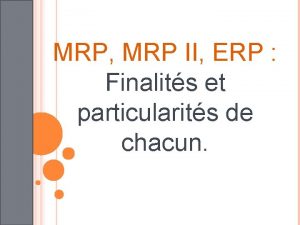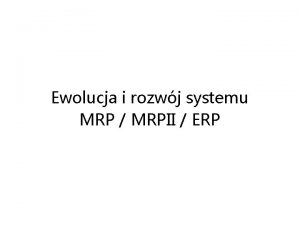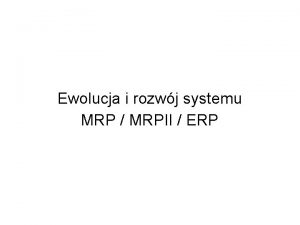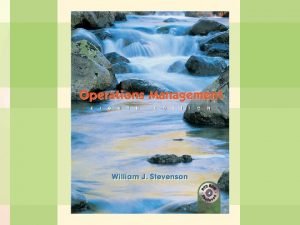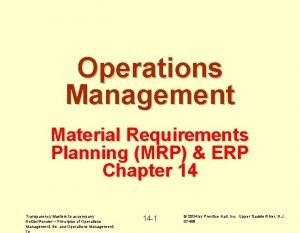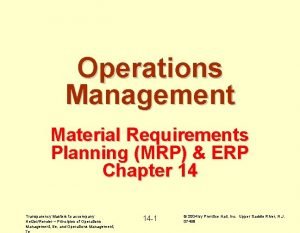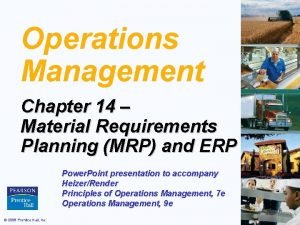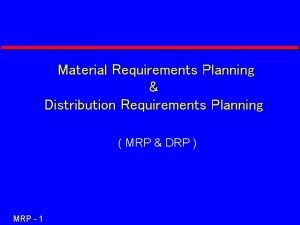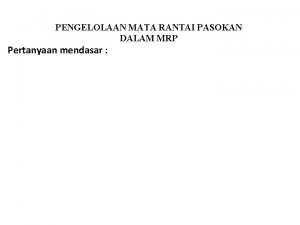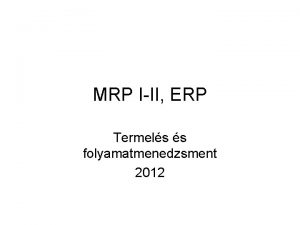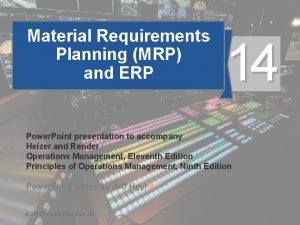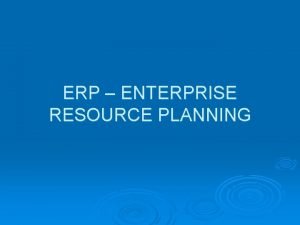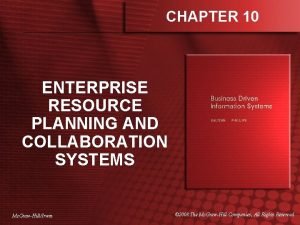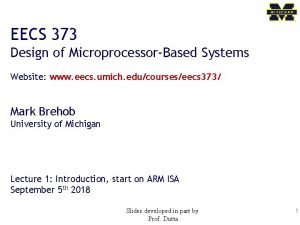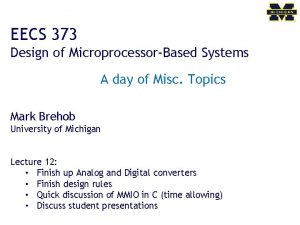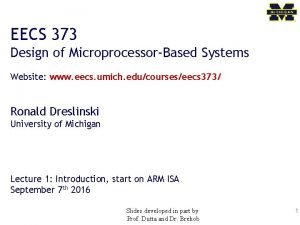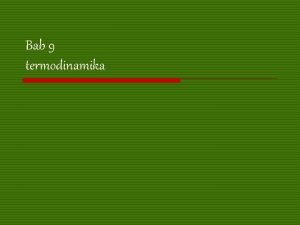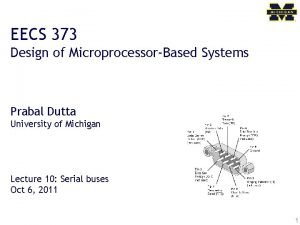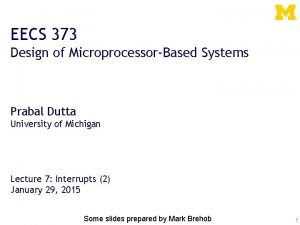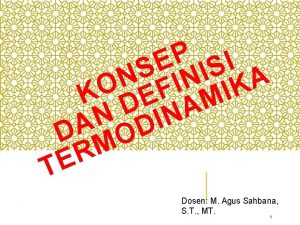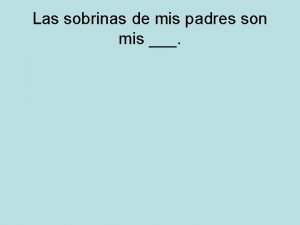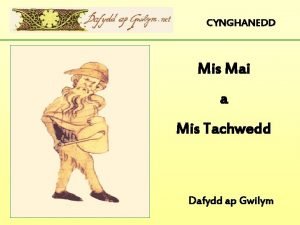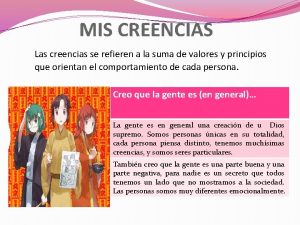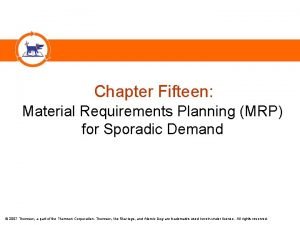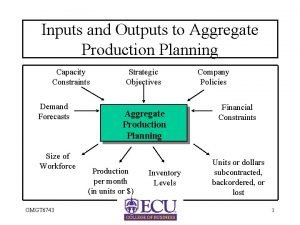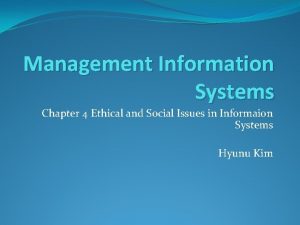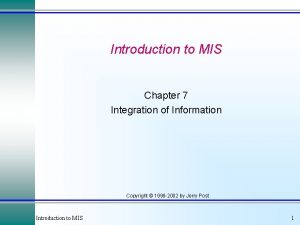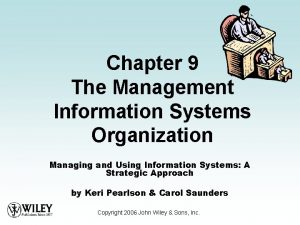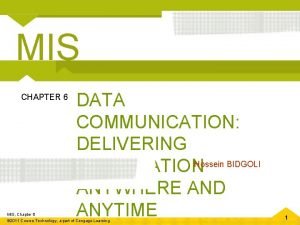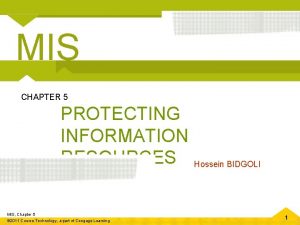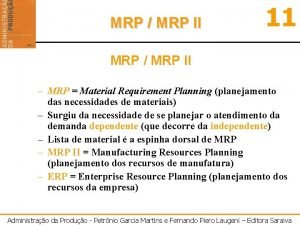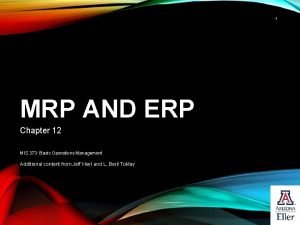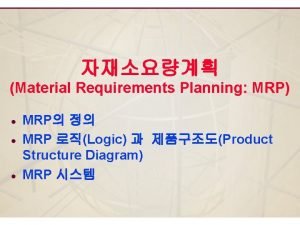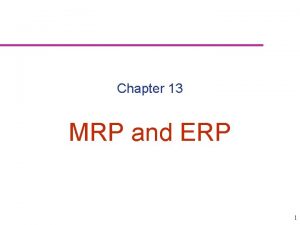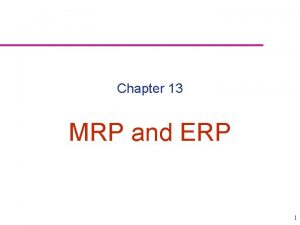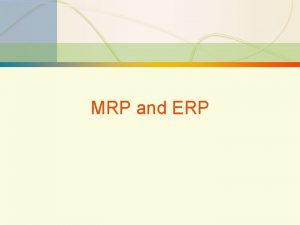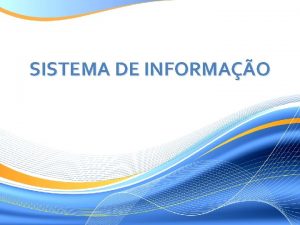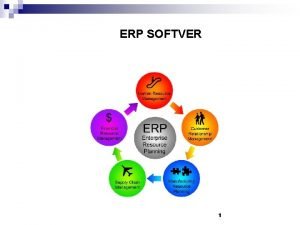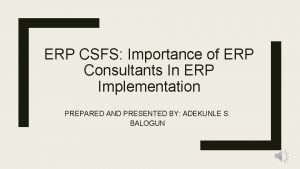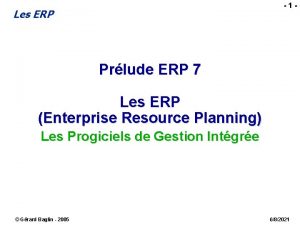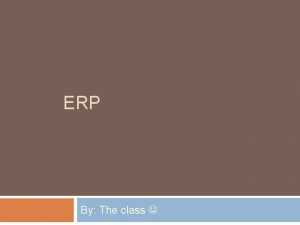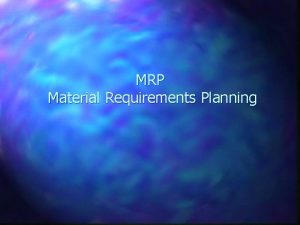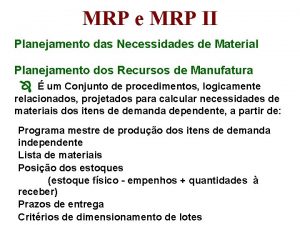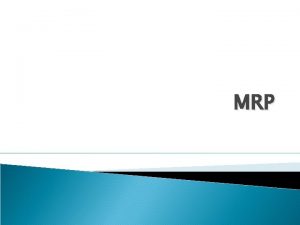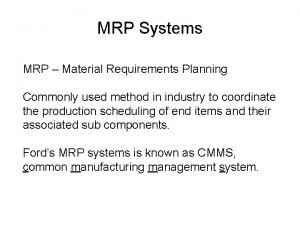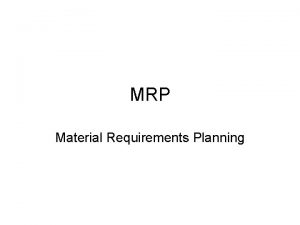1 MRP AND ERP Chapter 12 MIS 373





































- Slides: 37

1 MRP AND ERP Chapter 12 MIS 373: Basic Operations Management Additional content from Jeff Heyl and L. Beril Toktay

LEARNING OBJECTIVES • After this lecture, students will be able to 1. 2. 3. 4. Describe the inputs, outputs, and nature of MRP processing. Explain bill of materials Explain time-phased product structure Describe differences between MRP and ERP MIS 373: Basic Operations Management 2

MRP • Material requirements planning (MRP): • A computer-based information system that translates master schedule requirements for end items into timephased requirements for subassemblies, components, and raw materials. • The MRP is designed to answer three questions: 1. What is needed? 2. How much is needed? 3. When is it needed? MIS 373: Basic Operations Management 3

MRP OVERVIEW How much and when finished product is desired Composition of a finished products How much inventory is on hand or on order MIS 373: Basic Operations Management 4

MRP INPUTS • MRP Inputs • Master schedule • How much and when finished product is desired • Bill of Materials (BOM) • Composition of a finished products • Inventory Records • How much inventory is on hand or on order MIS 373: Basic Operations Management 5

MRP INPUTS: MASTER SCHEDULE • Master schedule: • States: • Which end items are to be produced • When these are needed • In what quantities (customer orders, forecasts, order from warehouses to build up seasonal inventories). Weekly Quantity Item X 11 Quantity MIS 373: Basic Operations Management 12 13 14 100 15 16 17 18 150 6

MRP INPUTS: MASTER SCHEDULE • Master schedule: • States: • Which end items are to be produced Item X • When these are needed • In what quantities (customer orders, forecasts, order from warehouses to build up seasonal inventories). Weekly Quantity Item X 11 Quantity MIS 373: Basic Operations Management 12 13 14 100 15 16 17 18 150 7

MRP INPUTS: MASTER SCHEDULE • Master schedule: • States: • Which end items are to be produced Item X • When these are needed at beginning of week 14 and at beginning of week 18 • In what quantities (customer orders, forecasts, order from warehouses to build up seasonal inventories). Weekly Quantity Item X 11 Quantity MIS 373: Basic Operations Management 12 13 14 100 15 16 17 18 150 8

MRP INPUTS: MASTER SCHEDULE • Master schedule: • States: • Which end items are to be produced Item X • When these are needed at beginning of week 14 and at beginning of week 18 • In what quantities (customer orders, forecasts, order from warehouses to build up seasonal inventories). 100 at beginning of week 14 150 at beginning of week 18 Weekly Quantity Item X 11 Quantity MIS 373: Basic Operations Management 12 13 14 100 15 16 17 18 150 9

CUMULATIVE LEAD TIME �The master schedule should cover a period that is at least equivalent to the cumulative lead time – Cumulative lead time » The sum of the lead times that sequential phases of a process require, from ordering of parts or raw materials to completion of final assembly. CLT = 9 weeks MIS 373: Basic Operations Management 10

CUMULATIVE LEAD TIME • Following the previous example, if CLT=9 • When should we start work for the demand on the week 14? • When should we start work for the demand on the week 18? Weekly Quantity Item X 11 Quantity MIS 373: Basic Operations Management 12 13 14 100 15 16 17 18 150 11

MRP INPUTS: BILL OF MATERIALS • Bill of Materials (BOM) • A listing of all of the assemblies, subassemblies, parts, and raw materials needed to produce one unit of a product • Product structure tree • A visual depiction of the requirements in a bill of materials, where all components are listed by levels MIS 373: Basic Operations Management 12

ASSEMBLY DIAGRAM AND PRODUCT STRUCTURE TREE parent component parent Level 0 = end item component Level 1 Level 2 Amount needed for assembly at the next higher level only MIS 373: Basic Operations Management 13

LOW-LEVEL CODING • Low-level coding • Restructuring the bill of materials so that multiple occurrences of a component all coincide with the lowest level at which the component occurs • Example: 1 X requires: 2 B, 1 C, 6 D, 28 E, and 2 F X X: 1 Level 0 B: 2 x 1 = 2 Level 1 D: 3 x 2 = 6 E: 1 x 2 = 2 Level 2 D(3) E: 4 x 6 = 24 Level 3 E(4) MIS 373: Basic Operations Management B(2) C: 1 x 1 = 1 C E E(2) F(2) E: 2 x 1 = 2 F: 2 x 1 = 2 14

LOW-LEVEL CODING: 1 X X X: 1 Level 0 B: 2 x 1 = 2 Level 1 D: 3 x 2 = 6 E: 1 x 2 = 2 Level 2 D(3) E: 4 x 6 = 24 Level 3 E(4) B(2) C: 1 x 1 = 1 C E E(2) F(2) E: 2 x 1 = 2 F: 2 x 1 = 2 • 1 X requires: MIS 373: Basic Operations Management B: 2 C: 1 D: 6 E: 2+24+2=28 F: 2 15

LOW-LEVEL CODING: 10 X WITH ON HAND INVENTORY X Level 0 Level 1 • 1 X requires: B: 2 C: 1 D: 6 E: 28 F: 2 B(2) Level 2 D(3) Level 3 E(4) C E 10 X require: B: 2 x 10 -4=16 C: 1 x 10 -10=0 D: 6 x 10 -8=52 E: 28 x 10 -60=220 F: 2 x 10 -0=20 MIS 373: Basic Operations Management E(2) F(2) Does not consider item hierarchy! • On hand inventory B: 4 C: 10 D: 8 E: 60 F: 0 16

LOW-LEVEL CODING: 10 X WITH ON HAND INVENTORY X X: 10 Level 0 B: 2 x 10 - 4 = 16 Level 1 D: 3 x 16 – 8=40 Level 2 D(3) E: 4 x 40 – 60=100 Level 3 E(4) • 10 X require: B: 16 C: 0 D: 40 E: 100+16+0=116 F: 0 MIS 373: Basic Operations Management B(2) C E E: 1 x 16 = 16 E(2) C: 1 x 10 -10=0 F(2) F: 2 x 0 = 0 “Low-level coding” E: 2 x 0 = 0 • On hand inventory B: 4 C: 10 D: 8 E: 60 F: 0 17

MRP PROCESSING • MRP processing takes the end item requirements specified by the master schedule and “explodes” them into time-phased requirements for assemblies, parts, and raw materials offset by lead times MIS 373: Basic Operations Management Part E fabrication lead-time Material F delivery lead-time Sub assembly lead-time Final assembly lead-time 18

EXAMPLE: TIME-PHASED PRODUCT STRUCTURE • An example BOM The respective lead time A B(2) D(3) E(3) C(1) D(1) Parts / Product Process Lead Time A 10 B 15 C 10 D 15 E 10 Question: When do we start producing/ordering each part? MIS 373: Basic Operations Management 19

EXAMPLE: TIME-PHASED PRODUCT STRUCTURE • Let’s assume that we need 50 units of A… • Based on the BOM, we will need • Level 1: 100 units of B A • Level 2: 300 units of D Assembly • Level 1: 50 units of C B(2) • Level 2: 50 units of D • Level 2: 150 units of E D(3) • Putting together: E(3) C(1) D(1) Purchase • 100 B, 50 C, 350 D, 150 E MIS 373: Basic Operations Management 20

EXAMPLE: TIME-PHASED PRODUCT STRUCTURE • Let’s assume that we need 50 units of A… Delivery date for final product Parts-Products A B C D E MIS 373: Basic Operations Management 5 days 21

EXAMPLE: TIME-PHASED PRODUCT STRUCTURE • 50 units of A Start assembly for 50 units of A A B(2) C(1) Parts-Products D(3) A B C D E 5 days MIS 373: Basic Operations Management E(3) D(1) Parts / Product Process Lead Time A 10 B 15 C 10 D 15 E 10 22

EXAMPLE: TIME-PHASED PRODUCT STRUCTURE • 50 units of A Start assembly for 100 units of B A B(2) C(1) Parts-Products D(3) A B C D E 5 days MIS 373: Basic Operations Management E(3) D(1) Parts / Product Process Lead Time A 10 B 15 C 10 D 15 E 10 23

EXAMPLE: TIME-PHASED PRODUCT STRUCTURE • 50 units of A Start assembly for 50 units of C A B(2) C(1) Parts-Products D(3) A B C D E 5 days MIS 373: Basic Operations Management E(3) D(1) Parts / Product Process Lead Time A 10 B 15 C 10 D 15 E 10 24

EXAMPLE: TIME-PHASED PRODUCT STRUCTURE • 50 units of A Order 300 units of D for B’s process A B(2) C(1) Parts-Products D(3) A B C D E 5 days MIS 373: Basic Operations Management E(3) D(1) Parts / Product Process Lead Time A 10 B 15 C 10 D 15 E 10 25

EXAMPLE: TIME-PHASED PRODUCT STRUCTURE • 50 units of A Order 50 units of D for C’s assembly A B(2) C(1) Parts-Products D(3) A B C D E 5 days MIS 373: Basic Operations Management E(3) D(1) Parts / Product Process Lead Time A 10 B 15 C 10 D 15 E 10 26

EXAMPLE: TIME-PHASED PRODUCT STRUCTURE • 50 units of A Order 150 units of E for C’s assembly A B(2) C(1) Parts-Products D(3) A B C D E 5 days MIS 373: Basic Operations Management E(3) D(1) Parts / Product Process Lead Time A 10 B 15 C 10 D 15 E 10 27

MRP OUTPUTS: PRIMARY • Primary Outputs • Planned orders • A schedule indicating the amount and timing of future orders • Order releases • Authorizing the execution of planned orders • Changes • Revisions of the dates or quantities, or the cancellation of orders MIS 373: Basic Operations Management 28

MRP OUTPUTS: SECONDARY �Secondary Outputs �Performance-control reports �Evaluation of system operation, including deviations from plans and cost information • e. g. , missed deliveries and stockouts �Planning reports �Data useful for assessing future material requirements • e. g. , purchase commitments �Exception reports �Data on any major discrepancies encountered • E. g. , late and overdue orders, excessive scrap rates, requirements for nonexistent parts MIS 373: Basic Operations Management 29

ENTERPRISE RESOURCE PLANNING (ERP) • Enterprise Resource Planning (ERP) • ERP was the next step in an evolution that began with MRP • ERP typically has an MRP core • Many organizations use a functional structure. Information tends to flow freely within each function but less so between functions. • ERP represents an expanded effort to integrate standardized record keeping that will permit information sharing among different areas of an organization in order to manage the system more effectively • A system to capture and make data available in real-time to decision makers throughout the organization. • ERP systems are composed of a collection of integrated modules MIS 373: Basic Operations Management 30

ERP SOFTWARE MODULES Module Brief Description Accounting/Finance A central component of most ERP systems. It provides a range of financial reports, including general ledger, accounts payable, accounts receivable, payroll, income statements, ad balance sheets Marketing Supports lead generation, target marketing, direct mail, and sales Human Resources Maintains a complete data base of employee information such as date of hire, salary, contact information, performance evaluations, and other pertinent information Purchasing Facilitates vendor selection, price negotiation, making purchasing decisions, and bill payment Production Planning Integrates information on forecasts, orders, production capacity, on-hand inventory quantities, bills of material, work in process, schedules, and production lead times Inventory Management Identifies inventory requirements, inventory availability, replenishment rules, and inventory tracking Distribution Contains information on third-party shippers, shipping and delivery schedules, delivery tracking Sales Information on orders, invoices, order tracking, and shipping MIS 373: Basic Operations Management Supply Chain Facilitates supplier and customer management, supply chain visibility, 31

FOCUSED READING • Enterprise Resource Planning (ERP) 1. 2. 3. Enterprise resource planning (ERP)—A brief history 13 Common ERP Mistakes and How to Avoid Making Them ERP and Business Process Re-engineering • ERP: The Business Process Re-engineering Dilemma • To BPR, or not to BPR, that is the question 4. Cloud ERP • What Is Cloud ERP, and How Is It Different from Traditional Solutions? • Benefits of Cloud ERP Software • Instruction: • A group should have 4 persons, each with a different article • Take a few minutes to read the article you have; take notes • Share the key ideas from your reading to your team members

ERP HISTORY • MRP: focus on cost reporting, materials, manufacturing • tapes • IBM • 1960~1970 • MRPII: scheduling, procurement • 1980 s • ERP • SAP, Peoplesoft, • 1990 • Client-server architecture

ERP COMMON MISTAKES • Poor plan • Need time to plan and to revise • Revise process • Not hiring correct people • • • Experience third party IT consultants Referencing Restrictions, lack of capability No sufficient training Underestimation: accurate data, time, resources, training, • Maintenance strategy

ERP & BUSINESS PROCESS RE-ENGINEERING • Take place before ERP system selection • Output of BPR ERP • To be process vs. as is process • • Difference ways to do business globally Process standardization after acquisition Legacy systems Make sure the process lead to higher values

CLOUD ERP • Cloud ERP vs. traditional ERP • Traditional: • Cloud: • Outsource operation, easy to setup, monthly/annually fee • Minimal initial cost • Automate operation • cons • Less control, data security, service outage

KEY POINTS • The usage of components in production of assembled items depends on how many of each component are needed per item, and how many items are to be produced. Hence the term dependent demand. • MRP is a tool used for dependent-demand components, to assist in making the two basic decisions in inventory management: how much of each component to order, and when to order it. • ERP is a software-based enterprise-wide system that allows access to production, sales, accounting, warehouse, and supply chain information. MIS 373: Basic Operations Management 37
 Mrp et erp
Mrp et erp Mrpii
Mrpii Pętla mrp
Pętla mrp Mpr erp
Mpr erp Material requirement planning advantages and disadvantages
Material requirement planning advantages and disadvantages Erp in operations management
Erp in operations management What is mrp in operations management
What is mrp in operations management Output of mrp
Output of mrp Pertanyaan tentang manajemen rantai pasokan
Pertanyaan tentang manajemen rantai pasokan Termelési vezérprogram
Termelési vezérprogram Closed loop mrp
Closed loop mrp Enterprise resource definition
Enterprise resource definition Scm, crm, and erp are all extended erp components.
Scm, crm, and erp are all extended erp components. Eecs 373
Eecs 373 Eecs 511
Eecs 511 Eecs 373
Eecs 373 Suatu sistem menyerap kalor 1500 kalori dari lingkungannya
Suatu sistem menyerap kalor 1500 kalori dari lingkungannya Dte vs dce pinout
Dte vs dce pinout Eecs 373
Eecs 373 Math 373
Math 373 Adiabatis adalah
Adiabatis adalah Eecs 373
Eecs 373 Diagnosrelaterade grupper
Diagnosrelaterade grupper Marty stepp
Marty stepp Mis realidades mis valores proyecto de vida
Mis realidades mis valores proyecto de vida La sobrina de mi padre es mi
La sobrina de mi padre es mi Mis mai a mis tachwedd
Mis mai a mis tachwedd Mis mai a mis tachwedd
Mis mai a mis tachwedd Mis actos son un reflejo de mis creencias
Mis actos son un reflejo de mis creencias Mrp crp
Mrp crp Mdp and mrp examples
Mdp and mrp examples Inputs of aggregate planning
Inputs of aggregate planning Mis chapter 4
Mis chapter 4 Mis reports examples
Mis reports examples Management information systems wiley
Management information systems wiley Mis chapter 6
Mis chapter 6 Mis chapter 5
Mis chapter 5 Mis chapter 3
Mis chapter 3
